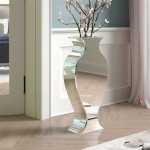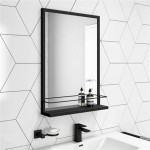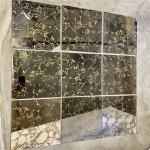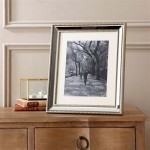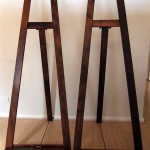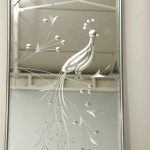How To Hang A Mirror On A Brick Wall Without Drilling
Hanging a mirror on a brick wall traditionally involves drilling holes and using wall anchors, which can be a daunting task for many. Fortunately, several effective methods allow for hanging mirrors without the need for drilling, preserving the integrity of the brickwork. These methods rely on strong adhesives, specialized hangers, and clever techniques suitable for various mirror sizes and weights.
Adhesive-Based Solutions
Using adhesives specifically designed for brick and heavy items offers a straightforward approach. These adhesives create a strong bond between the mirror and the brick surface, eliminating the need for any holes.
- Clean the surface: Ensure the brick surface is clean and free of dust, debris, and loose mortar. Use a brush and a damp cloth to achieve a clean surface area for maximum adhesion.
- Choose the right adhesive: Select an adhesive formulated for brick and rated for the weight of the mirror. Consider high-strength construction adhesive or mirror adhesive specifically designed for this purpose.
- Apply the adhesive: Follow the manufacturer’s instructions for application. Typically, the adhesive is applied in lines or dots to the back of the mirror or directly onto the wall.
- Mount the mirror: Carefully position the mirror against the wall and apply firm, even pressure for the duration recommended by the adhesive manufacturer. Use temporary supports to hold the mirror in place while the adhesive cures.
Brick Clips and Clamps
Brick clips and clamps are another excellent option for hanging mirrors without drilling. These specialized hangers grip the brick’s edge, providing a secure hold without damaging the brick itself. This method is particularly suitable for thinner mirrors or in situations where the mortar joints are accessible.
- Assess the mortar joints: Ensure the mortar joints are in good condition and free of cracks or crumbling. The clips rely on the integrity of the mortar for a secure hold.
- Select appropriate clips: Choose brick clips that are appropriately sized for the weight and thickness of the mirror.
- Attach the clips: Securely attach the clips to the mortar joint according to the manufacturer’s instructions. Ensure they are positioned at the correct height and spacing for the mirror.
- Hang the mirror: Hang the mirror onto the clips, ensuring it sits securely in place.
Heavy-Duty Adhesive Strips
While often used for lighter objects, certain heavy-duty adhesive strips are designed to hold substantial weight and can be used for hanging moderately sized mirrors on brick. These strips offer a quick and easy installation process.
- Prepare the surfaces: Clean both the back of the mirror and the brick wall thoroughly. Any dust or debris will compromise the adhesive bond.
- Apply the strips: Attach the adhesive strips to the back of the mirror according to the manufacturer’s instructions. Generally, multiple strips are required, evenly distributed across the back surface.
- Mount the mirror: Remove the protective backing from the adhesive strips and carefully position the mirror on the brick wall. Apply firm and even pressure for the recommended duration to ensure a secure bond.
Wire Hanging Systems and Masonry Hooks
For heavier mirrors, a wire hanging system used in conjunction with masonry hooks can provide a reliable solution. While masonry hooks do require small pilot holes, the impact on the brick is minimal compared to traditional wall anchors.
- Install masonry hooks: Carefully pre-drill small pilot holes into the mortar joints using a masonry bit. Insert the masonry hooks into the holes, ensuring they are securely in place.
- Attach wire to the mirror: Attach D-rings or other suitable hardware to the back of the mirror and secure picture wire to these attachment points.
- Hang the mirror: Hang the mirror from the masonry hooks using the picture wire.
Considerations for Different Mirror Types and Weights
Choosing the appropriate hanging method depends significantly on the size and weight of the mirror. Lighter, smaller mirrors can often be hung using adhesive strips or brick clips, while heavier mirrors require more robust solutions like adhesive designed for heavy items, masonry hooks, or a combination of methods.
- Lightweight mirrors: Adhesive strips or brick clips are generally suitable.
- Medium-weight mirrors: Heavy-duty adhesive strips or a combination of adhesives and brick clips might be required.
- Heavy mirrors: Adhesive specifically designated for heavy-duty projects, masonry hooks and wire, or a combination of these methods are recommended for the most secure installation.
Ensuring Safety and Stability
Regardless of the chosen method, ensuring the safety and stability of the hanging mirror is paramount. This involves proper surface preparation, using appropriate weight ratings for adhesives and hangers, and following manufacturer instructions meticulously. Periodically checking the mirror’s stability is also recommended.
- Weight limits: Always adhere to the manufacturer’s weight limits for adhesives, strips, clips, and hooks.
- Surface preparation: A clean and dry surface is crucial for optimal adhesion and grip.
- Regular checks: Periodically inspect the mirror and its hanging mechanism to ensure continued stability.

3 Simple Ways To Hang A Mirror On Wall Without Nails Wikihow

Quickest Way To Hang Mirror On Brick Wall

How To Hang Decor On Brick Or Stone Without Drilling

How To Hang A Heavy Mirror On Brick Fireplace Drill Into Dans Le Lakehouse

How To Hang Stick Stuff On Brick Wall Without Drilling

3 Simple Ways To Hang A Mirror On Wall Without Nails Wikihow

How To Hang Stick Stuff On Brick Wall Without Drilling

How To Hang A Heavy Mirror On Brick Wall Hanging Tips Easy Tutorial Homify

How To Hang A Heavy Mirror On Brick Wall Hanging Tips Easy Tutorial Homify

Mounting A Picture On Brick Wall Without Drilling Ehow

